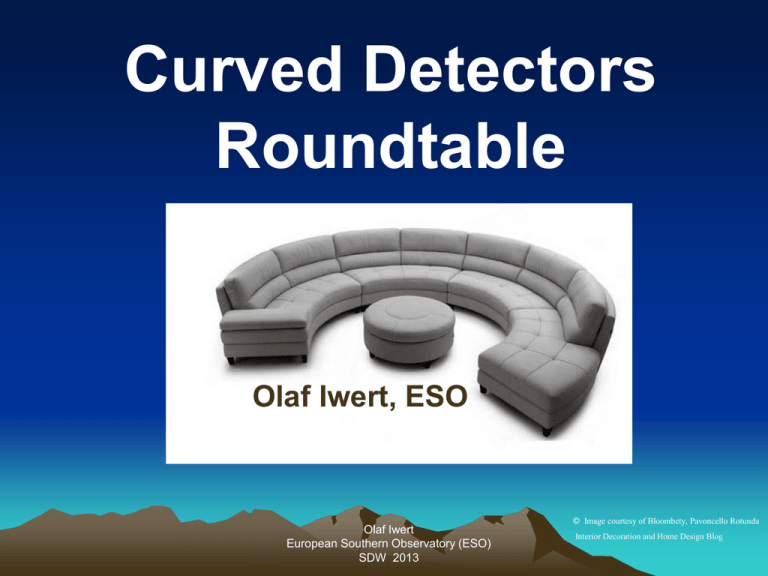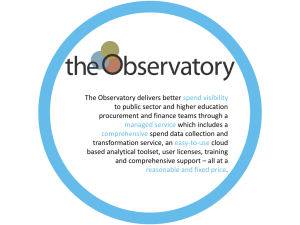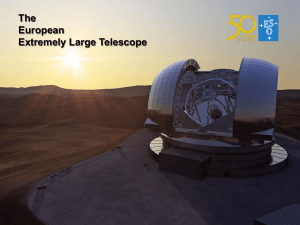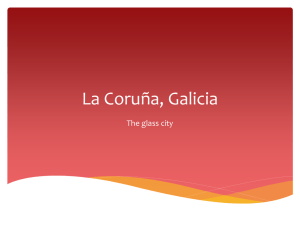Introduction - Center for Detectors
advertisement

Curved Detectors Roundtable Olaf Iwert, ESO Olaf Iwert European Southern Observatory (ESO) SDW 2013 © Image courtesy of Bloombety, Pavoncello Rotunda Interior Decoration and Home Design Blog Curved Roundtable Challenge Do NOT think ‘Detectors’, but think Optics and Detector ! Optical SYSTEM Performance Olaf Iwert European Southern Observatory (ESO) SDW 2013 Curved Detectors Roundtable How we normally think: Olaf Iwert European Southern Observatory (ESO) SDW 2013 © www.appdynamics.com Flat Scientific CCD Detectors So far fighting very hard for the State-of-the-Art of flat detectors – what a long way it took for them to “grow up” and get mature. Thinned silicon & Backside illuminated Cryogenic operation Olaf Iwert European Southern Observatory (ESO) SDW 2013 Detector Mosaic for wide field of view ESO OmegaCAM CCD mosaic 268 M Pixel, 32 CCDs, ~ 24 x 24 cm2 light sensitive area Olaf Iwert European Southern Observatory (ESO) SDW 2013 Curved Detectors Roundtable What we sometimes should do: Olaf Iwert European Southern Observatory (ESO) SDW 2013 Curved Detectors Roundtable What then often happens: Olaf Iwert European Southern Observatory (ESO) SDW 2013 Curved Detectors Roundtable This shows: If you want to think outside the box: Get mentally rid of your box now ! Purpose of this roundtable session Olaf Iwert European Southern Observatory (ESO) SDW 2013 From an optical point of view: The first detector to think about is a 3 dimensionally curved detector Petzval Field Curvature © http://www.microscopyu.com/tutorials/java/aberrations/curvatureoffield/ Flat detectors: • require field flattener • more optics & errors • less transmission (faint objects!) • large FOV not correctable • optics complex & expensive Olaf Iwert European Southern Observatory (ESO) SDW 2013 Nature does not use (Spherically) Curved Detectors for fun Some hundred million years of human evolution can’t be wrong: Olaf Iwert European Southern Observatory (ESO) SDW 2013 So, why not curve electronic detectors ? • Interaction of Optical designers / Detector nerds • Somewhere we have to start with a new SYSTEM concept to overcome current limits…. • [A. Einstein]: ‘ If at first the idea is not absurd, then there will be no hope for it. ‘ Olaf Iwert European Southern Observatory (ESO) SDW 2013 Olaf Iwert European Southern Observatory (ESO) SDW 2013 Roundtable Cast of Characters: Olaf Iwert ESO David Ouellette & Michael Lesser ITL, U. of Arizona Barry Burke MIT/Lincoln Labs Shouleh Nikzad JPL Motivation Optical Examples Applications 60x60 mm2, thick detector curved, 500 mm Radius Tested at – 120 C SST focal plane built with curved detectors 5000 mm Radius Curving pioneer, diff. approaches, Modulating Radius ‘on the fly’ 7 Minutes 7 Minutes 7 Minutes 7 Minutes + YOU: Remember my Email ccdworld ? Olaf Iwert European Southern Observatory (ESO) SDW 2013 Cylindrical versus 3D curvature Disposable cameras: Curved focal plane Cheap optics Remarkable image quality Cylindrical curved CCD Opticians mostly need 3 dimensional curvature Mostly spherical & concave, but also convex & evtl. aspherical Olaf Iwert European Southern Observatory (ESO) SDW 2013 © Fuji Photo v. Jazz Photo (Fed. Cir. 2005); home.online.no ; Michael Lesser Curving Schemes, not detailed here (1) • Patterned Silicon • < 100 % Fill factor Olaf Iwert European Southern Observatory (ESO) SDW 2013 © Rim Stanford; Rogers, Univ. Illinois Curving Schemes, not detailed here (2) Olaf Iwert European Southern Observatory (ESO) SDW 2013 © Rogers, Univ. Illinois; Ball Aerospace Prime Focus on: Curvature process, where • detector produced conventionally • and afterwards curved (CCD / CMOS / IR) Only possibility, since semiconductor manufacturing only works with flat wafer processing Olaf Iwert European Southern Observatory (ESO) SDW 2013 © ASML Telescope Instrument Optics Examples Olaf Iwert European Southern Observatory (ESO) SDW 2013 1. Why a Curved Detector (for E-ELT)? Flat Detector Curved Detector Vignetting Optical characteristics (both camera optics): Focal length: 300 mm F/Number: 1.50 Entrance pupil diameter: 200 mm Entrance pupil location:125 mm in front of 1st lens Angular field of view: 25 º Detector: up to 100 x 100 mm With a flat detector often NO optical design with an affordable number of lenses can be found with identical transmission and identical field of view. Olaf Iwert European Southern Observatory (ESO) SDW 2013 2. Why a Curved Detector (for E-ELT) ? • Avoid: extreme lens radii / cementing / Flat Detector aspherical elements • Simplify optics and reduce cost • Improve image quality (spot / vignett.) FoV Limit • Enable larger field of view • Increase back focal distance Curved Detector Curved Detector F = 375 mm Pupil: 250 mm located 125 mm in front of the 1st surface F/1.50 Wavelength range 480 – 1000 nm Same concept, Largest FoV Olaf Iwert European Southern Observatory (ESO) SDW 2013 3. Why a Curved Detector ? Flat Detector: • Lens mounting difficult • 7 elements • 3 aspheric surfaces • Some expensive materials • Centering tolerances due to high incidence on surfaces • Complex interface to CCD Flat Detector 11:54:45 Both Cameras: FOV 100 x 120 mm, F 1.8 Curved Detector (R 500 mm): • Only 4 elements • Only 2 moderate aspherical surfaces • Only classical material • Centering tolerances relaxed / low incidence angle on surfaces • Back focal distance >200 mm to detector Olaf Iwert European Southern Observatory (ESO) SDW 2013 Curved Detector 113.64 Positions: 1-9 Scale: 0.22 MM 27-Feb-13 4. Large telescopes & fast optics need high curvature accuracy ? NO ! • E-ELT: 39 m • Instrument Optics F1.5 • Image scale on detector ~ 283 µm for 1 arcsec ∆z +/- 50 µm gives negligible image blur of +/- 33 µm • Even F1 possible • More ‘shape reserve’ than with current flat detectors! Olaf Iwert European Southern Observatory (ESO) SDW 2013 5. Is optical improvement bound to one specific curvature radius ? (1) FLAT DETECTOR NEO/LEO Space Junk Telescope 350 mm aperture Prime Focus Corrector 4 degree field diameter (similar to SST, but 24 x 36 mm2 DSLR detector), 2003 by A. Rakich Whole field: 80% encircled energy in ø 7.4 µm Olaf Iwert European Southern Observatory (ESO) SDW 2013 5. Is optical improvement bound to one specific curvature radius ? (2) 4.7 µm Diameter Improvement factors (vs. flat): NOW CURVED DETECTOR, R = 300 mm Resolution 1.57 Energy Concentration 2.5 6 µm Diameter Improvement factors (vs. flat): Resolution 1.25 Energy Concentration 1.56 Less CURVED DETECTOR, R = 500 mm Some curvature already helps in many optical designs - must not be the ultimate one - much better than the flat detector Olaf Iwert European Southern Observatory (ESO) SDW 2013 Other Applications: Microscopes Military applications Mass-market products From high-end items to low-cost items Olaf Iwert European Southern Observatory (ESO) SDW 2013 Microscope Optics – similar problem (1) • Field Curvature ~ Magnification • Field curvature is very annoying: Manual field scanning by (manual) focusing Olaf Iwert European Southern Observatory (ESO) SDW 2013 © http://www.microscopyu.com/tutorials/java/a berrations/curvatureoffield/ Microscope Optics – similar problem (2) Optical correction for some field curvature: Olaf Iwert European Southern Observatory (ESO) SDW 2013 © http://www.microscopyu.com/tutorials/java/a berrations/curvatureoffield/ Microscope Optics – similar problem (3) Correction possible since some years, BUT: • Large FOV at high magnification is not correctable (fraction of field only) • Reduced working distance <> Illumination • Reduced transmission • Other optical errors • Complexity / Cost A curved detector could overcome this – relatively small size, but high curvature Olaf Iwert European Southern Observatory (ESO) SDW 2013 © http://www.microscopyu.com/tutorials/java/a berrations/curvatureoffield/ Olaf Iwert European Southern Observatory (ESO) SDW 2013 DARPA / IDA / MTO activities (1) Defense Advanced Research Projects Agency / Institute for Defense Analysis / Microsystem Technology Office HARDI Program, Hemispheric Array Detector for Imaging, IDA document NS-D-4268, January 2011 MONTAGE Program Interest in curved detectors, as of: • Off-axis aberrations • Limited FOV • Image post processing unless exotic optics used • Complicated optics / high cost Olaf Iwert European Southern Observatory (ESO) SDW 2013 DARPA / IDA / MTO activities (2) Defense Advanced Research Projects Agency / Institute for Defense Analysis / Microsystem Technology Office Robot cameras for Advanced Mine Detection System Miniature unmanned aerial vehicles (compact, lightweight) WFOV, Variable High Resolution in ROI, Zoom capability, 3D, Video MIT: 15 mm Curvature radius MTF improvement spectacular ! Olaf Iwert European Southern Observatory (ESO) SDW 2013 (U) The MONTAGE program aims to implement a revolutionary change in the design principles for imaging sensor systems, enabling radical transformation of the form, fit, and function of these systems for a wide variety of high-value DoD applications. Significant improvements in the performance, affordability, and deployability of imaging sensor systems will obtain from rational codesign and joint optimization of the imaging optics, the photo sensor array and the post-processing algorithms. Specific demonstrations include reduction of the depth/thickness of an imaging sensor by an order of magnitude without compromising its light gathering ability or resolution. This dramatic reduction in thickness will then allow the imaging sensors to be deployed conformally around a curved surface of a platform (e.g., UAV, tank, or helmet). Furthermore, the flexibility generated by the incorporation of post-processing in the image formation will allow variable resolution image formation, which in turn reduces the data load for subsequent image exploitation and communication systems. Advanced post-processing algorithms will support video operation at frame rates in excess of 10 frames per second using standard computing platforms. Program Plans: - Develop novel optical designs allowing depth reduction by 10X. - Concurrent with optics design, develop sensor array design and post-processing algorithms to realize signal-to-noise ratio and resolution of comparable optical aperture. - Demonstrate ability to allocate highest spatial resolution to specified regions of interest in the image while maintaining medium resolution elsewhere. - Develop architectures for surpassing detector size-limited resolution and potentially exceed optically limited resolution. - Demonstrate operation of a thin imaging system deployed on a curved surface. - Demonstrate real time performance of thin imaging systems in representative DoD applications with performance evaluated using application-specific metrics for image quality, sensor cost, power consumption, mechanical properties. Olaf Iwert European Southern Observatory (ESO) SDW 2013 It’s not a Trick – it’s a SONY Patent (1) Curved Detector Very detailed patent, suggests actual experimental work: • CMOS Different curving techniques described, e.g.: • Thermal expansion • Vacuum suction Modification of curvature on the fly by pressure / magnetic field (central portion) Olaf Iwert European Southern Observatory (ESO) SDW 2013 © SONY Patent New trend: Full frame sensor (24x36mm2) mirrorless cameras Conventional SLR (full frame) Camera Main goals : • Compact • Lightweight • Best image quality with least optics, especially image corners • Less back focal distance >> No room for field flattener >> easier with curved detector • Lower production cost • Exchangeable Lenses Mirrorless Full Frame Camera Olaf Iwert European Southern Observatory (ESO) SDW 2013 ©http://en.wikipedia.org/wiki/File:Flan ge_Focal_Length_%282_types_cam era%29.PNG#file It’s not a Trick – it’s a SONY Patent (2) Optics for Curved Detector Sony patent 2013-61476 in Japan Back focal distance minimized Curved detector: 4 lenses Already built with flat detector: >= 8 lenses (Nikon, Olympus) Curved detector: >= 7 lenses 4 lenses (Olympus) Not possible with flat det. + ZOOM in connection with lens shift and curvature modification Olaf Iwert European Southern Observatory (ESO) SDW 2013 FROM DIFFERENT APPLICATIONS TO REALIZATION: ESO / ITL CURVING PROCESS Olaf Iwert European Southern Observatory (ESO) SDW 2013 Results and potential of a novel curving process for large area scientific imagers Olaf Iwert , ESO David Ouellette & Michael Lesser ITL, U. of Arizona, USA Bernard Delabre, ESO Olaf Iwert European Southern Observatory (ESO) SDW 2013 ESO Feasibility Study 2010 Basic requirements for monolithic spherically curved CCDs: Goals: Combine state-of the-art CCD performance with curvature Get a working curved CCD and test its performance cold Olaf Iwert European Southern Observatory (ESO) SDW 2013 ESO / ITL curving approach (2) University of Arizona Imaging Technology Laboratory (ITL) did the main development for the curved detectors under contract with ESO, with the following goals: • Characterize large CCD detector before curvature • Curve large CCD thick (spherically, concave) > 200 µm • Achieve curvature radius 500 … 250 mm • Support device permanently • Characterize electro-optical performance cold • If successful, extend to thinned CCD Olaf Iwert European Southern Observatory (ESO) SDW 2013 ESO / ITL curving approach (3) The first trials to achieve the curvature of working CCDs looked really good: Olaf Iwert European Southern Observatory (ESO) SDW 2013 ESO / ITL curving approach (4) Until this happened: “At least they take some minutes now before they explode – that’s progress…” Olaf Iwert European Southern Observatory (ESO) SDW 2013 ESO / ITL curving approach (5) After process training and optimisation: 1st curved working CCD, cold first light Curvature Radius ~500 mm (3D), device size 60 x 60 mm2 Frontside illuminated, Thickness ~200 um, permanently supported Three curved CCDs have been produced, two were delivered to ESO Olaf Iwert European Southern Observatory (ESO) SDW 2013 ESO / ITL curving approach (6) Cryogenic Measurement Results (1): Stress Testing : ~ 10 cycles of dunking into liquid Nitrogen did not show any problems Olaf Iwert European Southern Observatory (ESO) SDW 2013 ESO / ITL curving approach (7) Measurement Results (2): ~ 500 mm curvature radius over 60 x 60 mm2 area, fairly symmetrical: Olaf Iwert European Southern Observatory (ESO) SDW 2013 ESO / ITL curving approach (8) Cryogenic Measurement Results (3): -120 Deg C: 600 sec dark exposure Flat field exposure No more cosmetic defects than before (Strip patterns are due to metal bussing on frontside of this CCD type) Olaf Iwert European Southern Observatory (ESO) SDW 2013 ESO / ITL curving approach (9) Cryogenic Measurement Results (4): 4k x 4k Testing after curvature shows basically no difference to results before / reference device Olaf Iwert European Southern Observatory (ESO) SDW 2013 ESO / ITL curving approach (10) Measurement Results Conclusion: All cryogenic test results show that the electro-optical performance before and after curvature is almost identical: - Charge Transfer - Imaging Defects - Readout Noise - Dark Current (This is in contrast to theoretical performance deterioration) Once packaged, no reliability issues occurred Olaf Iwert European Southern Observatory (ESO) SDW 2013 ESO / ITL curving approach (11) Potential for further improvements: • Curvature shape & repeatability • Curvature radius << 500 mm requires more development effort • Larger detectors • Extension to thinning Olaf Iwert European Southern Observatory (ESO) SDW 2013 ESO / ITL curving process: 2 Vac (1) Overview of process components: Olaf Iwert European Southern Observatory (ESO) SDW 2013 ESO / ITL curving process: 2 Vac (2) Overview of process steps: A B C G E 51 H F I D J Olaf Iwert European Southern Observatory (ESO) SDW 2013 ESO / ITL curving process: CURVING PROCESS HARDWARE: Olaf Iwert European Southern Observatory (ESO) SDW 2013 General View: • • Conclusions Curved detectors have core applications in different fields Our application is the extreme case for size & backside illumination, but also has the highest demand from the optical point of view (e.g., ELT instruments) Curved Detectors: • For the first time ever a detector of 60 x 60 mm2 size has been curved to ~ 500 mm radius – fully functional • Reliability in cold operation and measurement results show no noticeable performance degradation • Thinning of the curved detector is compatible with the developed process • All objectives of this R&D project have been reached • We are interested in partners for further development Olaf Iwert European Southern Observatory (ESO) SDW 2013 Credits This R&D project illustrates: In Theory: Theory and Practice are the same In Practice: They are not ! All CCD curving work for this project done by ITL, U. of Arizona, USA under contract to ESO. All CCDs supplied by Semiconductor Technology Associates (STA). Thank you very much Olaf Iwert European Southern Observatory (ESO) SDW 2013







